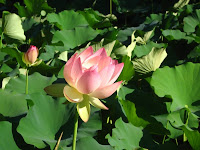 Conservation organizations encourage homeowners to maintain their properties as if they were wildlife preserves. The National Wildlife Federation provides certification for qualified backyards as wildlife habitats. Audubon at Home also provides advice along similar lines. Other organizations, like the Maryland Native Plant Society, provide resources for finding and growing native plants.
Conservation organizations encourage homeowners to maintain their properties as if they were wildlife preserves. The National Wildlife Federation provides certification for qualified backyards as wildlife habitats. Audubon at Home also provides advice along similar lines. Other organizations, like the Maryland Native Plant Society, provide resources for finding and growing native plants.
While this is good for wildlife, it can create conflicts with the local community. In some cases, the municipality intervenes; in other cases, the trouble may come from a homeowners association. The latest case comes from Edgewater Park, New Jersey. A woman had planted her property with native plants to attract birds, butterflies, and other creatures.
Wozniak said she moved to the neighborhood six years ago and has made an effort to comply with repeated notices from the township to clean up her property.
She removed a garbage can that was filled with birdseed from her front porch. She took down a shed that the township believed was in disrepair. She raked up piles of pine needles in her back yard.
Last month, however, the municipal property-maintenance inspector, Charles Gant, sent her a warning letter.
“Your property has become (a) blight to your neighborhood, with its overgrown landscaping, bushes and weeds,” the letter states. “There is accumulated debris and is in an unsafe condition.”
She has to appear in court on charges of "obnoxious growth." The township cited two reasons for concern:
Dougherty said mosquitoes gather in areas that are “not kept up,” and those insects can carry West Nile virus....
Dougherty said Wozniak's yard would be better suited in a country setting, not in a residential community.
“We are very much concerned about the impact of this property on the community and the nonconformity of her property compared to the properties around her,” she said.
The issue of property conformity appears frequently in these types of cases. (For comparison, see
this case from Utah in which a woman was arrested for not watering her lawn.) Townships may have some legitimate reasons for enacting and enforcing weed laws. True neglect of a property could result in health and safety problems or lead to the spread of invasive species such as kudzu or ailanthus.
However, too often weed laws seem to be enforced to impose arbitrary standards on properties that simply look different. These standards reflect an understanding of humans and nature as fundamentally antagonistic; any vegetation that is not carefully controlled is a weed and an eyesore. Natural landscaping does not pose the same problems foreseen in weed laws; the commonly-cited defenses of weed laws such as vermin, mosquitos, and allergenic pollen are more likely on a manicured lawn than in a natural garden. Instead, natural landscaping adds value to the neighborhood by increasing biodiversity in the midst of suburban monoculture. Weed laws and their enforcement ought to be reformed to account for a better understanding of ecology.
For a thorough explanation of natural landscaping and weed laws (and how to defend against prosecution), see this article on the EPA website. It refutes most of the common arguments against natural landscapes and describes their relation to Aldo Leopold's Land Ethic. See also this discussion of natural landscaping and urban planning.

















.jpg)



